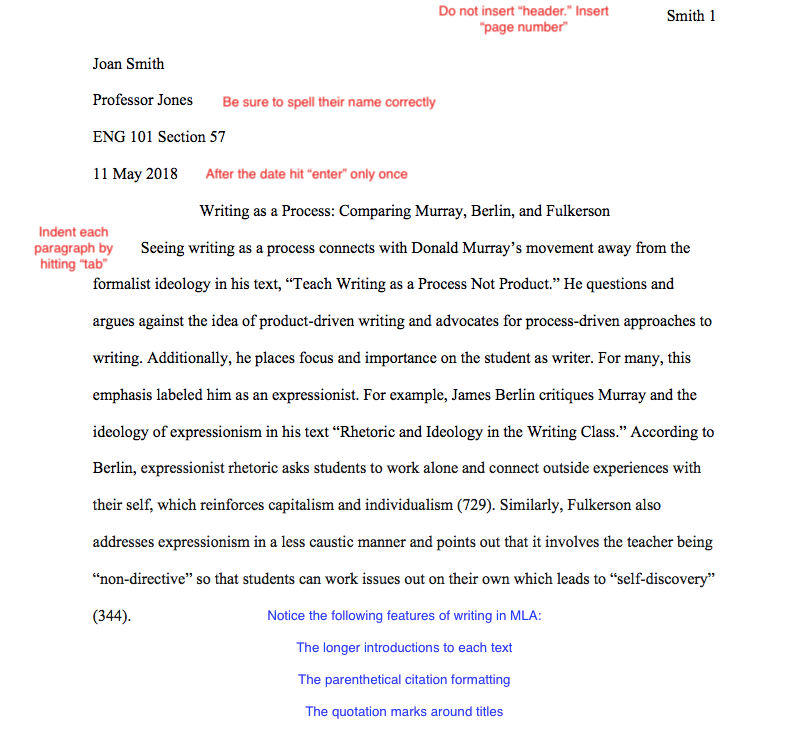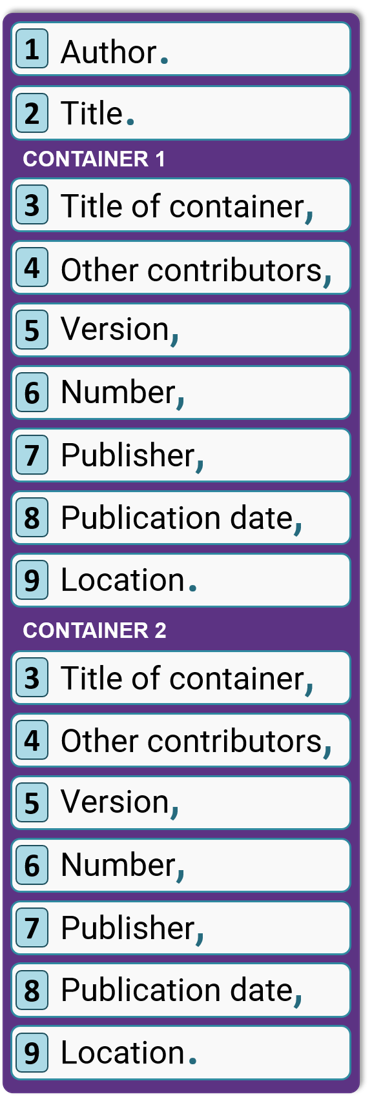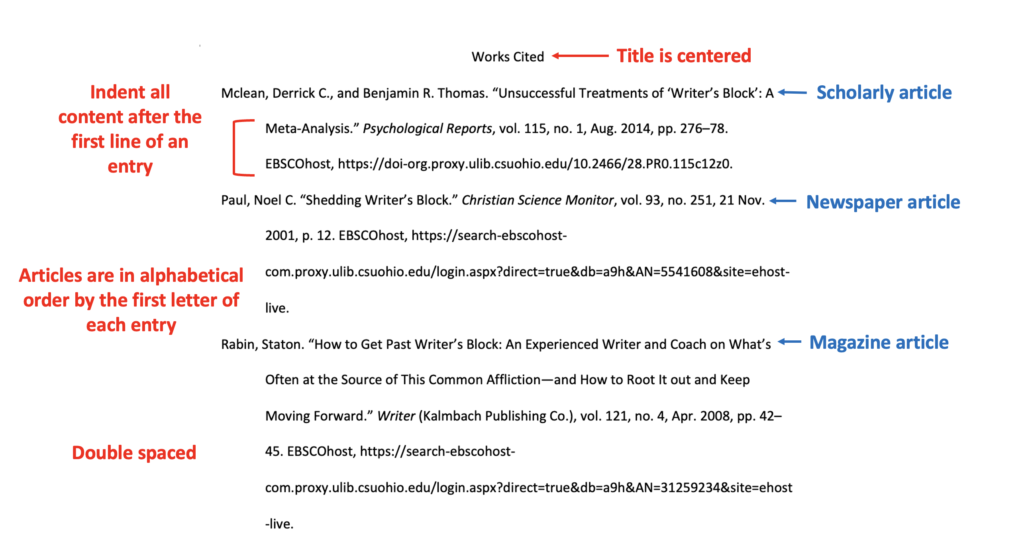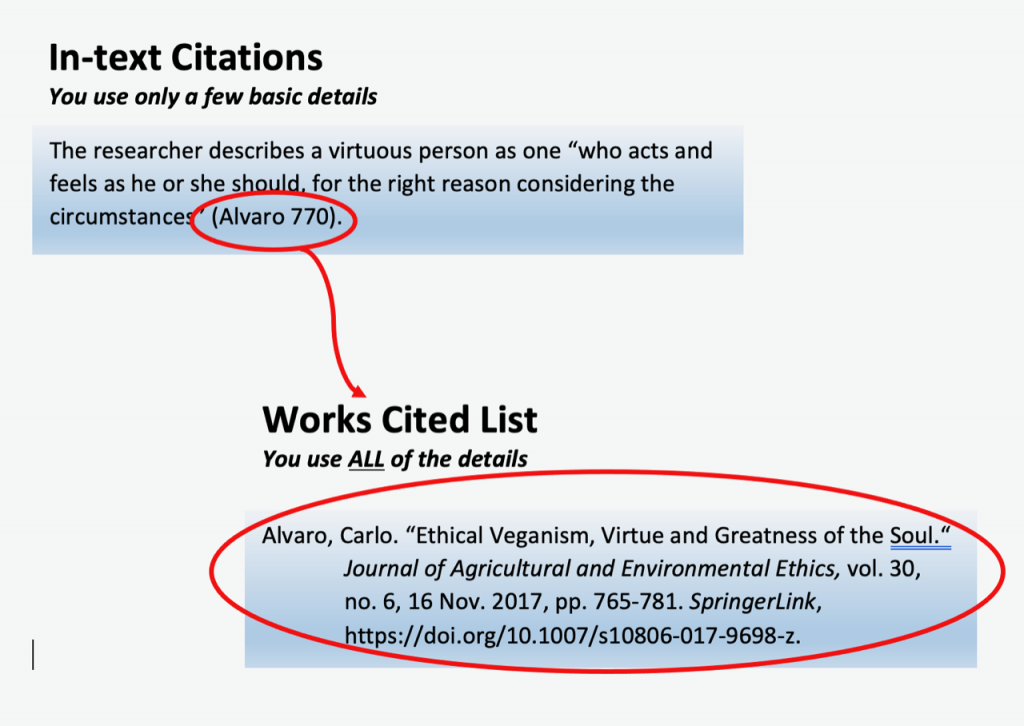Chapter 18: MLA Format
“History must share with reading, writing, and arithmetic first rank as the most important subjects in the curriculum. Understanding the issues on which citizens of a republic are expected to vote is impossible without an understanding of the past.” —Walter Cronkite
Why Use a Specific Style?
As mentioned in the introduction to this part, citation styles are guidelines that determine how to cite sources in written work. These guidelines provide structure and consistency by forcing researchers to standardize the content and format of their citations and references. When the title and date are always found in the same place in every citation, research is a bit easier because the information is presented in a consistent way.
There are over a dozen types of styles, but in this section of the textbook, we will specifically address MLA Style guidelines.
What is MLA Style?
MLA Style is a set of guidelines covering many different aspects of scholarly writing including:
- formatting (title page setup, margins, line spacing, font, headings, etc.)
- mechanics of style (spelling, punctuation, capitalization, italics, etc.)
- references/citations
The MLA Style Handbook is published by the Modern Language Association. MLA Style is used primarily in the humanities, including literature, visual arts, music and philosophy.
Check out the MLA Style website for more info!
Formatting Your Paper in MLA
You should always use Times New Roman 12-point font (unless otherwise directed by your instructor) and one-inch margins. The entire manuscript should also be double-spaced. Below is an annotated example of other important features you should consider and include in your MLA manuscripts:

This link will download a Word document setup in MLA format: MLA Template 2025
Two Parts of MLA Citations
In MLA Style, there are two parts to every citation: an in-text citation and a Works Cited list citation.
In-text citations use only a few details of the source, enough to locate its matching reference citation in the Works Cited list.
Works Cited list citations provide more information about the source, so that the reader can find it if they wish.
We will discuss both of these separately first and then together later. First, we will discuss Works Cited list citations.
MLA Citation: Works Cited Entries
Core Elements
With the 2016 update (8th edition), MLA changed and simplified the way your Works Cited entries should be formatted. Instead of offering a specific way to format each and every source, MLA offers a streamlined approach using something called “containers.” The 9th edition continues to use this system.

These containers, pictured in Figure 18.1, provide you with the required elements, order, and punctuation for each of your Works Cited entries.
As you work to format your Works Cited entries, you will notice that some sources require only one container, depicted above (Figure 18.1). These are sources that you access directly from their original publication, such as books, an online magazine article, and general websites. You should follow the order of items listed in the container, following the simplified punctuation rules you see in the container as well. Not all elements will apply to every citation. Use only the elements that apply. You will place a period after the author and the title of the source. Then, you should place commas after each item until the last item used in the container.
The MLA Style Center provides additional explanations about the core elements as well as an interactive template, which you can use to build your works cited entries.

Two containers are required for sources that you access through places like library databases. An example of MLA’s “two container” structure is depicted in Figure 18.2 above.
Here, you will notice there is a place for the first container, with the original publication information. Below the first container, the second container provides publication information for where you retrieved that information. For example, a journal article you access through your library’s databases will have its original publication information (container 1) and access information from the online database (container 2).
Guide to Core Elements
This guide will give an overview of how and when to list each of the elements seen in Figure 18.2. Not all elements will apply to every citation. Use only the elements and containers that apply to your source. Follow the punctuation given with the exception that the last item used in a container ends with a period. For example, if the location is not needed, end the entry with the publication date and a period.
Sometimes a second container is needed. For example, an episode contained within a series which was viewed on a streaming platform, or an article contained within a journal which is contained within a database would be supplemental elements.
Below is an explanation of how to style each element.
Author
If there is no person (or people) listed as the author, do not use this element.
- A single author should be written: Last name, First name Middle name
- For two authors, only invert the first author’s name. List the names in the order in which they appear on the source.
- For three or more authors, use et al. (which means, ‘and others’).
- When citing an edited book, add a descriptive label (“editor”) after the name.
Examples
One author: Last name, First name.
Smith, John.
Two authors: Last name, First name, and First name Last name.
Example
Robinson, Angela. “History Shows Why It’s Time for a Black Woman to Sit on the Supreme Court .” The Washington Post, 1 Feb. 2022, https://www.washingtonpost.com/outlook/2022/02/01/history-shows-why-its-time-black-woman-sit-supreme-court/.
End the author element with a period.
Title of Source
- This is the title of an article or chapter or a description if there is no title.
- Include both the title and subtitle separated by a colon [:].
- Capitalize the first word of the title and subtitle, plus all other important words.
- Enclose in “quotation marks:”
- If the title is part of a larger work, such as a story in an anthology, an article in a journal, or a Web page from a Web site
Examples
“Parasites – Trichinellosis (also known as Trichinosis).” Centers for Disease Control and Prevention, 29 Sept. 2020, www.cdc.gov/parasites/trichinellosis/disease.
In this example, there is no author, so this element is excluded. Instead, the citation begins with the title of the article in quotation marks.
Robinson, Angela. “History Shows Why It’s Time for a Black Woman to Sit on the Supreme Court .” The Washington Post, 1 Feb. 2022, https://www.washingtonpost.com/outlook/2022/02/01/history-shows-why-its-time-black-woman-sit-supreme-court/.
In this example, the author is listed first. Then, the title of the article is listed in quotation marks.
End the title of source element with a period. After this, all elements end with a comma.
Title of Container
- When a source is part of a larger work, the larger work is called the “container.”
- The container is italicized and followed by a comma.
- Containers can be:
- Periodicals (magazines, journals, newspapers)
- Anthologies (books which contain short stories, essays, poetry, etc.)
- Entire Web sites (which contain individual web pages)
- Library or other online databases (which contain articles, books, etc.)
Figure 18.3 Website Eating Well
In the example in Figure 18.3, the website Eating Well is a container and the articles within them are the sources.
Example
DeAngelis, Danielle. “Jameela Jamil Opened Up About Her Unapologetic Food Choices on Vacation: ‘Eat the Food You Crave.’ Eating Well, reviewed by Emily Lachtrupp, M.S., RD, Dotdash Meredith Publishing, 19 July 2024, https://www.eatingwell.com/jameela-jamil-eating-what-she-wants-on-vacation-8677496.
Other Contributors
- Contributors other than the author are named in the entry if they are important to your research or the identification of the source (i.e. editors and translators).
- When citing a source with both an author and editor, list the author first and the editor after the title of the source.
In the example above, the other contributor is a dietician, Emily Lachtrupp, who reviewed the article for accuracy.
Example
Huber, Suzanne. “The Impact of Food Allergies on Social and Emotional Development.” Childhood Psychological Disorders: Current Controversies, edited by Alberto M. Bursztyn, Praeger, 2011, pp. 143-66.
Introduce this element with the role the contributor played and then their name (first name last name format).
Version
If a source carries a notation that it is a work in more than one form (i.e. book edition), identify the version.
- Abbreviate edition (ed.) and revised (rev.).
- Use sentence capitalization. This means if the previous element ended in a comma, the first word isn’t capitalized. See example.
Examples:
- Updated ed.,
- 5th ed.,
- unabridged version,
- 7th ed.,
- Expanded ed.,
Example
Lee, Harper. To Kill a Mockingbird. 1st ed., J. B. Lippincott & Co., 1960.
Number
- Journals are typically numbered with volume (vol.) and issue numbers (no.).
- If you are using a multi-volume set, include the volume (vol.) number.
Example
Gosine, Kevin, and Emmanuel Tabi. “Disrupting Neoliberalism and Bridging the Multiple Worlds of Marginalized Youth via Hip-Hop Pedagogy: Contemplating Possibilities.” Review of Education, Pedagogy, and Cultural Studies, vol. 38, no. 5, 2016, pp. 445-467. Research Gate, doi: 10.1080/10714413.2016.1221712.
Publisher
- Only include the first publisher listed, unless the source was published by multiple independent organizations. Separate independent publishers with a forward slash [/].
- Abbreviate publisher names in the following cases:
- Omit business words like Company, Corporation, Incorporated, and Limited
- Replace University Press with UP (i.e. Oxford UP, U of California P, MIT P).
- A publisher’s name may be completely omitted for the following types of sources:
- Web page whose publisher is the same as the name of the overall website
- Periodical (journal, magazine, newspaper)
- Work published by the author
Publication Date
- Dates should be given as fully as they appear in your sources.
- If multiple dates are listed, cite the date most meaningful to your use of the source.
- Format as: Day Month Year. Abbreviate the names of months longer than 4 letters
Location
- In print sources, a page number (preceded by p.) or a range of page numbers (preceded by pp.) specifies the location.
- In online sources, location is indicated by the URL, DOI, or Permalink.
- URL: Copy in full from your Web browser, but omit http:// or https://
- DOI: Journal articles are often assigned “Digital Object Identifiers”. When possible, cite a DOI (preceded by doi:) instead of the URL.
- Permalink: Web sources (especially Library databases) often provide stable URLs, called “permalinks”. When possible, use these instead of the URL.
General order of content in an MLA-formatted Works Cited Entry
Online Article
- Author(s). Use the format Last Name, First Name Middle Name or Initial. If there are multiple authors, use and before the last author’s name. If there is no author, leave this blank.
- “Title of the Article.” Include the title of a shorter work in quotation marks and use headline-style capitalization.
- Title of the Newspaper or Publisher, Use italics for the title of a longer work like a newspaper or online publication and use headline-style capitalization
- Publication date, Use the format: Date Abbreviated Month Year.
- URL.
Examples
Kato, Brooke. “Eating this one fruit every day leads to better sleep, heart health: new research.” New York Post, NYP Holdings, Inc., 20 July 2024, https://nypost.com/2024/07/20/lifestyle/eating-this-one-fruit-every-day-leads-to-better-sleep-heart-health-new-research/.
Oram, Adam and Aashna Gheewalla. “The OG Apple Watch Ultra Is Well Under $500 at Woot for Prime Day.” CNET, Red Ventures, 19 July 2024, https://www.cnet.com/deals/the-apple-watch-series-9-is-still-available-with-ongoing-prime-sales-at-just-280/
Faverio, Michelle, et al. “Teens, Social Media and Mental Health.” Pew Research Center, 22 Apr. 2025, http://pewresearch.org/internet/2025/04/22/teens-social-media-and-mental-health/
“Sleep Apnea.” Medline Plus, National Library of Medicine, 30 March 2021, https://medlineplus.gov/sleepapnea.html
Print Book
- Author(s). Use the format Last Name, First Name Middle Name or Initial. If there are multiple authors, use and before the last author’s name.
- Title of the Book. Use italics for the title of a longer work like a book and use headline-style capitalization.
- Edition. If there are multiple editions, use the format 1st/2nd/3rd ed.,
- Publisher,
- Publication date.
Examples
Minot, Stephen. Three Genres. Pearson, 2003.
Sennett, Richard, and Jonathan Cobb. The Hidden Injuries of Class. Vintage Books, 1973.
Smith, John, et al. Writing and Erasing: New Theories for Pencils. Utah State UP, 2001.
eBook
- Author(s). Use the format Last Name, First Name Middle Name or Initial. If there are multiple authors, use and before the last author’s name.
- Title of the Book, Use italics for the title of a longer work like a book and use headline-style capitalization.
- Editors If there is one editor, use the format edited by Last Name, First Name. If there are multiple editors, use and before the last author’s name.
- Publisher,
- Publication date.
- Database, Note: Use italics for names of databases.
- URL or permalink.
Example
Examples
Nixon, Robin. Learning PHP, MySQL and JavaScript. 4th ed., e-book ed., O’Reilly Media, 2014. EPUB.
Wright, Jonathan V., and Lane Lenard. Why Stomach Acid Is Good for You: Natural Relief from Heartburn, Indigestion, Reflux, and GERD. E-book ed., M. Evans and Company, 2012.
YouTube
- Author(s). If the primary creator or author is clear, list the author using the format Last Name, First Name Middle Name or Initial. If there are two authors, use and before the last author’s name. For three or more authors, list the first author’s name and then “et al.” If the primary creator or author is unclear, omit the Author element and begin with the title of the video.
- “Title of the Video.” Include the title of a shorter work in quotation marks and use headline-style capitalization.
- Title of Publisher, The publisher is YouTube. Use italics for the title of a longer work like a newspaper or online publication and use headline-style capitalization
- Contributors, If the video’s creator is not specified in the author element, include the words “uploaded by” with the name of the account that uploaded the video.
- Publication date, This is the date that the video was posted. Use the format: Date Abbreviated Month Year.
Examples
Miller, Faith. “How to view instructor feedback in Blackboard Ultra.” YouTube, 6 July 2023, https://www.youtube.com/watch?v=MqHLP7GSnKg.
“Digoxin Nursing Pharmacology NCLEX (Cardiac Glycosides).” YouTube, uploaded by RegisteredNurseRN, 9 Mar. 2019, www.youtube.com/watch?v=S73GT32EE48.
Compiling & Formatting
Once you have constructed your citations according to MLA rules, there are a few more steps to complete the Works Cited list.
- Center the words “Works Cited” at the top of the page.
- Alphabetize the citations by author’s last name, or by the first main word of the title if there is no author. (When alphabetizing, ignore A, An, and The at the beginning of citations.)
- Make sure all lines are double-spaced.
- Apply “hanging” indents to all citations: The first line of the citation is not indented. All subsequent lines are indented 0.5 inch.
Examples

See Excelsior OWL for more specific examples of MLA works cited formats for different sources.
MLA Citation: In-Text Citations
The map you create is a list of bibliographic work at the end of the essay, a collection of each and every outside source integrated into your writing. In MLA format, this list of sources is a Works Cited page. In APA format, this list of sources is a References page.
The basics of in-text citation
MLA citations follow specific conventions that distinguish them from other styles. In-text citations convey two important pieces of information to the reader: 1. where your source integration begins and ends, and 2. from which source on your Works Cited list the integrated material comes.
In-text citations are usually comprised of two parts: 1. the signal phrase or narrative lead-in, and 2. a parenthetical citation, so named because they are enclosed in parentheses.
The author’s last name can appear in either the signal phrase or the parenthetical citation for your source; however, page number(s) must only appear in the parentheses at the end of the sentence.
A complete in-text citation in MLA format includes three components (remember the Sourse Burger from Chapter 17?):
- a signal phrase (may contain author’s name)
- the original source material (quoted, paraphrased, or summarized), and
- a parenthetical citation (include author’s name if not in the signal phrase; must include page number)
See Chapter 17 for more detail on these elements.
For sources with page numbers, such as books and articles that were originally published in print publications, even if you access them using a research database like Academic Search Complete, place the page number in the parenthetical citation. In MLA, we do not use the word “page” or the abbreviations “p.” or “pg.” before the page numbers.
Example
Anna Quindlen claims, “Words can resonate through generations for us all” (27).
- Anna Quindlen claims = signal phrase
- “Words can resonate through generations for us all” = the quoted material
- (27) = the parenthetical citation
| Variations: | Example: |
|---|---|
| In-text citation at the end of a sentence: | Some researchers strongly dispute the Committee’s conclusion (Smith and Jones 10). |
| Author name as part of a sentence: | Smith and Jones dispute the Committee’s conclusion (10). |
| Source cited within another source: | Clark’s study (qtd. in Smith and Jones 10) indicates that…
In this situation, your Works Cited page will contain the article by Smith and Jones. |
Mentioning Author in the Text
The first time that you mention a source in a paper, you need to introduce the source. For this introduction, you can include the author’s full name and a bit of description about the text that this author or these authors produced.
How to cite a source the first time you mention it
In discussing the act of reading, Donald Hall, an American writer and scholar, states “it seems to me possible to name four kinds of reading, each with a characteristic manner and purpose” (15).
Each time you reference a source that you have already introduced (which would be called successive mentions of the source), you give only the author(s) last name(s).
Example
Hall also claims that the four types of reading are “skimming, scanning, intensive, extensive” (17).
- If you name the authors in the signal phrase, you do not need to add the author(s)’ names in the parenthetical citation, too.
Author Not Mentioned in the Text
If you do not name your author(s) in a signal phrase, then you must place the last name(s) only in the parenthetical citation. In doing so, do not place a comma between the author name(s) and the page number.
Example
There are four types of reading are “skimming, scanning, intensive, extensive” (Hall 17).
Research reveals there are “four kinds of reading, each with a characteristic manner and purpose” (Hall 15).
For more information on signal phrases, see Chapter 17.
Page Numbers, etc.
Page numbers should appear as they do in the source. If the source is only one page, do not add a page number in the citation. Examples of how numbers could appear in citations include 422, xxvi, and D32.
If other location types are used within a citation, they are listed often using abbreviations. The table below shows some location options with the appropriate abbreviations. When using any of these location types, add a comma within the citation after the author’s name. Only use the location type if they are included in the source. For example, do not use line or paragraph numbers if they are not included in the source referenced.
| Location | Appropriate Abbreviation |
|---|---|
| chapter(s) | ch. or chs. |
| line | Do no abbreviate. Write out line or lines. |
| paragraph(s) | par. or pars. |
| scene | sc. |
| section(s) | sec. or secs. |
If an ebook is used, use page numbers that are consistent across devices. Chapter numbers are also acceptable. However, do not use location numbers as they can vary in different devices.
More Than One Source Mentioned in Sentence
If you need to cite more than one source in your in-text citation, you should use a semicolon to separate the sources.
Variations of Parenthetical Citations
| Variations: | Example: |
|---|---|
| One, or two authors: | (Jones 7), (Dunn and Diaz 44) |
| Three or more authors: | (Phipps et al. 45) |
| Organization as an author: | (United States, Dept. of Labor 221) |
| Govt agency website with no author, use title: | (“Salmonella”) – the agency will be the publisher in the full citation |
| No page number: | (Jones) |
| An eBook with chapters but no page numbers: | (Hawthorne, ch. 2) |
| No author – use the first word of the book title: | (Infrastructure 3) |
| No author – use the first word of the article title: | (“Economy” 3) |
| To clarify the author, if necessary: | (N. Smith 9) |
| More than one work from the same author: | (Smith “Project” 194) or (Austen, Persuasion 54) |
| If information in a paragraph comes from non-consecutive pages in the same work: |
(Smith 6+) |
| If the information comes from multiple sources: | (Smith 6; Jones 55) |
| Poems without page numbers: | (The Raven, lines 1-2) |
| Plays: | (Miller 1.3.12-14) – the numbers refer to act, scene, lines |
| Identifying location in film or video: | (Big Bang 00:03:16-00:04:05) or simply (Big Bang) |
| If a quotation appears at the end of a sentence: | The Committee reported “street repairs are ongoing” (Jones 52). |
Additional Resources
The Purdue OWL online writing lab is another great source of information on the MLA Formatting and Style Guide. Visit their website at MLA Formatting and Style Guide (9th Edition) – Purdue OWL® – Purdue University.
- For more information about the general layout and formatting your essay in MLA, visit General Format – Purdue OWL® – Purdue University
- For more information about in-text citations in MLA, visit In-Text Citations: The Basics – Purdue OWL® – Purdue University
- For more information about the Works Cited page, visit MLA Works Cited Page: Basic Format – Purdue OWL® – Purdue University
Excelsior OWL MLA Style Guide also offers great resources and examples on their website.
For help with in-text citations, you might also check out this website and the video below: Citation Help
Attributions
MLA Style Guide by Golden West College Libraries is licensed under CC BY NC SA 4.0
MLA In-Text Citations by Golden West College Libraries is licensed under CC BY NC SA 4.0
Style Guide by Excelsior OWL is licensed under CC BY 4.0
MLA Style from Introduction to College Research by Walter D. Butler, Aloha Sargent, and Kelsey Smith is licensed under CC BY 4.0
12.3 MLA Citation: Works Cited Entries by John Brentar, Charlotte Morgan, and Emilie Zickel is licensed under CC BY-NC-SA 4.0
Choosing & Using Sources: A Guide to Academic Research by Teaching & Learning, Ohio State University Libraries is licensed under a CC BY 4.0.
Write Here, Right Now: An Interactive Introduction to Academic Writing and Research by Ryerson University is licensed under a CC BY 4.0
Understanding Citation Styles: MLA, APA, and Chicago Manual of Style Demystified by ResearchLeap is licensed under a CC BY 4.0
MLA Style Citations by Ulrike Kestler is licensed under a CC BY-NC-SA 4.0
Images & Multimedia by Excelsior Online Writing Lab is licensed under CC BY 4.0
Image Credits
Person looking at map Photo by Leah Newhouse on Pexels



